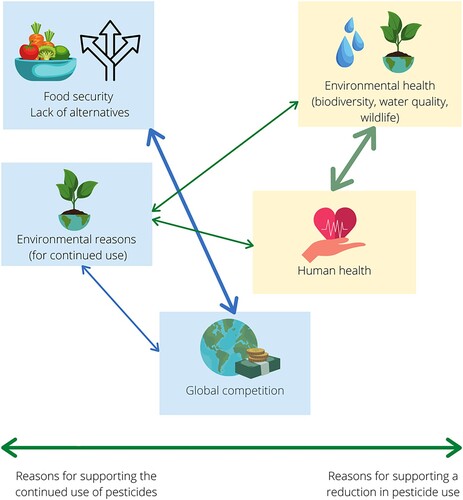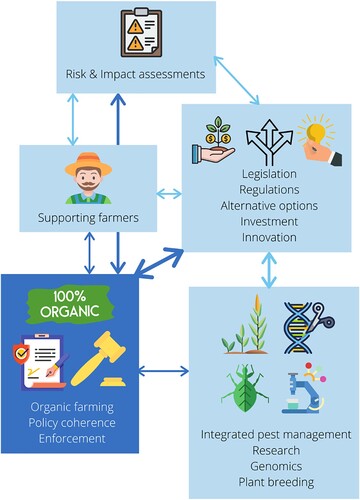Figures & data
Table 1. Framing for critical discourse analysis.
Table 2. Explanation of how coding was conducted.
Table 3. Approximate clustering of the participants who submitted responses the F2F public consultation with explicit reference to pesticides.
Table 4. Reasons shared for having unfavourable views towards pesticide use. These themes are not mutually exclusive, with submissions providing several reasons. Green = mentioned >5 times, orange = mentioned <5 times.
Table 5. Reasons given for not further restricting pesticide use. Green = mentioned >5 times, orange = mentioned <5 times.
Figure 1. Schematic illustration of simplified themes identified during code mapping. Links between themes are illustrated with arrows. Dark blue arrows represent the extent to which those in support of pesticide use referred to multiple themes within their submissions. Green arrows illustrate the same for submissions that gave reasons for reducing pesticide use. Arrow thickness illustrates how frequently these connections existed within submissions.

Table 6. Pesticide reduction options according to the participants who broadly supported the continued pesticide use. Green = mentioned >5 times, orange = mentioned <5 times.
Table 7. An overview of themes for ‘how’ pesticide reliance could be reduced in responses broadly arguing for the need to reduce pesticide use. Green = frequently mentioned ( = or >5 times), orange = infrequently mentioned (<5), blank = not mentioned.
Figure 2. Schematic diagram illustrating the major code groupings identified during MAXQDA analysis concerning how pesticide use could be reduced. The dark blue box shows narratives used by participants who clearly favoured a reduction in pesticide reliance, whilst light blue boxes represent those against further restrictions on pesticide use. The arrows represent connections between narrative groupings – again, dark blue arrows refer to submissions that broadly supported a reduction in pesticide reliance, whilst light blue arrows refer to those who argue against further restrictions. Thicker arrows reflect more frequent connections.

Figure 3. Schematic illustration of how public consultations are inadequate due to the risk of over-representing certain actors and a lack of deliberation.

